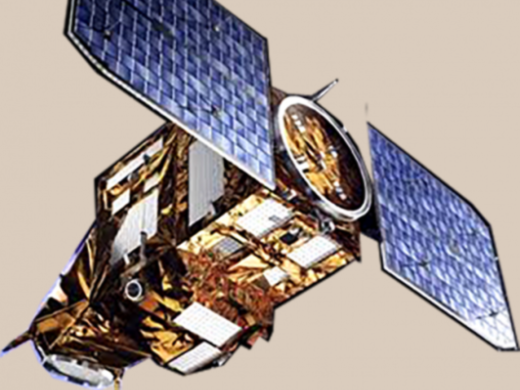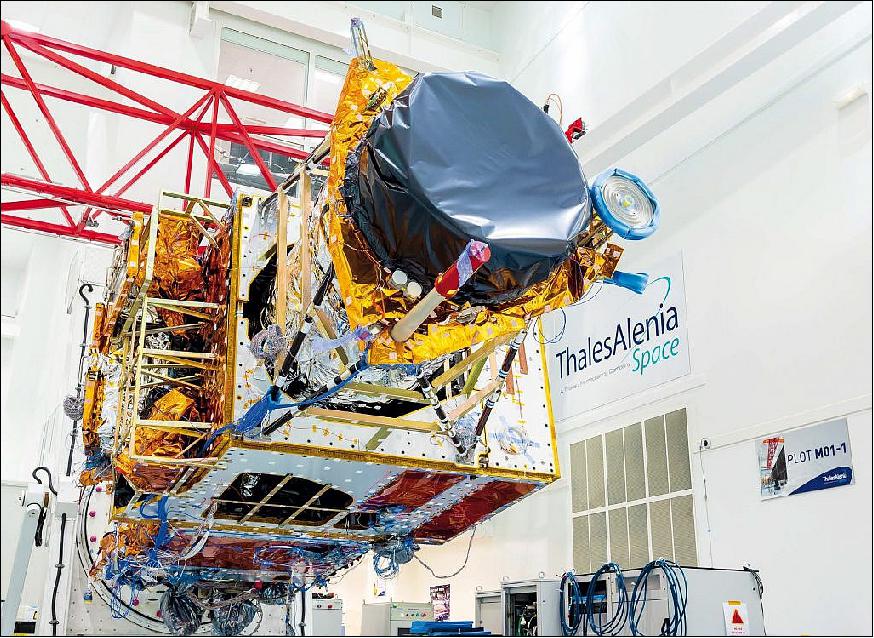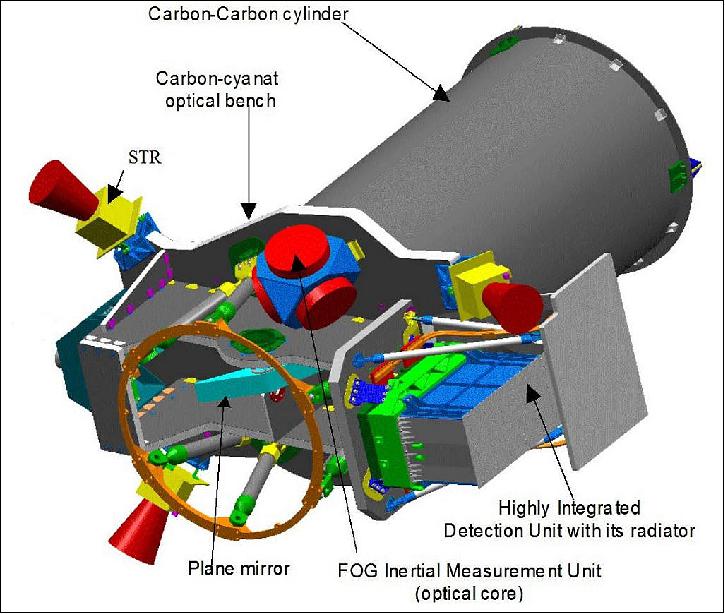Gokturk-1 Imaging Mission, Turkey
EO
Operational (nominal)
TUBITAK
Launched in December 2016, Göktürk-1 is a high-resolution optical satellite built by Telespazio for the Turkish Ministry of National Defense. The satellite has a wide range of military and civilian applications including reconnaissance, environmental monitoring, crop management, cadastral surveys, natural disaster damage assessment, and management of natural resources.
Quick facts
Overview
| Mission type | EO |
| Agency | TUBITAK |
| Mission status | Operational (nominal) |
| Launch date | 05 Dec 2016 |
| CEOS EO Handbook | See Gokturk-1 Imaging Mission, Turkey summary |

Summary
Mission Capabilities
Göktürk-1’s payload is HiRI (High Resolution Imager) of CNES (Centre National D’Etudes Spatiales), developed by Thales Alenia Space (TAS). The instrument is a pushbroom imager within the panchromatic and multispectral range with a high geo-location accuracy which has been developed from its use in the Pleiades satellite. HiRI onboard Göktürk-1 provides Turkey with high resolution optical reconnaissance as well as a wide range of civilian applications.
Performance Specifications
HiRI features a spatial resolution of 0.7 m and 2.8 m for the panchromatic (PAN) and multispectral (MS) bands, respectively. The imager has a swath width of 29 km at nadir with a 60° Field of Regard (FOR), and it is accurate to ±1 m with ground control points (GCP) and ±20 m without. Thanks to the satellite’s capability of imaging at angles of 30° to each side, a repeat cycle of approximately two days can be achieved over Turkish territory.
Göktürk-1 was launched into a sun-synchronous orbit at an altitude of 695 km at separation, inclined at 98.11°.
Space and Hardware Components
The satellite is based on the Proteus satellite bus developed by TAS and CNES, providing Göktürk-1 with a mass of 1060 kg and a design life of seven years. The Proteus satellite bus consists of an aluminium chassis with honeycomb panels mounted for the satellite’s subsystems. The spacecraft is three-axis stabilised, controlled by the ADCS (Attitude Determination and Control Subsystem), which includes star trackers, eight coarse sun sensors and two three-axis magnetometers; actuated by reaction wheels.
The communications subsystem is operated with S-band transceivers for data handling, which is then downlinked in X-band frequency.
Göktürk-1 Earth Observation Satellite
Spacecraft Launch Mission Status Sensor Complement References
Göktürk-1 is an Earth observation satellite of the Turkish Ministry of National Defence.
The satellite is intended to provide high-resolution Earth imagery for a wide range of military and civilian applications, including:
- reconnaissance,
- homeland surveillance,
- intelligence,
- environmental monitoring,
- forest control,
- cadastral surveys,
- identifying illegal construction sites,
- crop management,
- damage assessment after natural disasters,
- management of natural resources.
The Göktürk-1 program involves the construction of a Turkish satellite for Earth observation with a high-resolution optical sensor. The agreement between Telespazio and the Undersecretariat for Defence Industries of Turkey (SSM - Ministry of Defence) was signed in Ankara in July 2009. Already in December 2008, the Turkish Ministry of Defense had selected the offer of Telespazio among the various bidders for Göktürk-1. — In addition to the construction and launch of the spacecraft, the Telespazio-led team has agreed to provide Turkey with one fixed and one mobile ground station to receive imagery of the Göktürk spacecraft. 1)
SSM is the procurement authority under the Ministry of National Defense, TÜRKİYE. SSM's major function is putting into effect the decisions taken by the main decision-making body The Defense Industry Executive Committee which makes critical decisions relating to the defence industry, including major procurement projects.
Telespazio (Rome, Italy) and its sister company TAS (Thales Alenia Space) are the prime developers of the Göktürk-1 spacecraft. The satellite will use the Proteus multimission platform. The Italian-French contractor will also deliver a satellite assembly integration and test facility to be built at Turkey's TAI A.S. (Turkish Aerospace Industries, Inc.) company with assistance from TurkSat, Turkey's national telecommunications operator. TAI A.S. is designated as the main local partner with the purpose of building Göktürk-1 in its national satellite assembly, integration and test centre at Ankara. 2)
Further local industrial partners next to TAI A.S. are Aselsan A.S., TUBITAK Uekae (Technological and Scientific Research Council of Turkey), Roketsan A.S. and TR Tecnoloji. The goal of the government of Turkey is to infuse their home industry with the capability of developing their own future spacecraft.
Telespazio, the prime contractor and system integrator, is building the entire ground segment for the system to carry out the in-orbit operation and data acquisition and processing. Telespazio is also responsible for satellite launch, early orbit and test services.
The Turkish industry has been involved in the system design and development phase and in supplying some subsystems. In particular, local partners will assist in the building of the data acquisition station, the Satellite Integration Center, mission planning systems and remotely sensed data processors.
Spacecraft
The Göktürk-1A satellite has a dry mass of about 1,060 kg and a design life of seven years. The bus is of Proteus platform heritage developed by TAS and CNES. The Proteus satellite platform consists of an aluminium chassis to which honeycomb panels are mounted to provide attachment points for the various satellite subsystems. The satellite platform allows a payload assembly to be integrated in a modular fashion using four bolt interfaces. Thermal control relies on passive radiators along with a heater system to maintain components at their critical survival temperatures.
The spacecraft is 3-axis stabilized with dimensions of 4.2 m x 2.5 m x 1.6 m.
The ADCS (Attitude Determination and Control Subsystem) is in charge of precisely calculating the satellite's three-axis orientation in space and using a series of actuators to orient the satellite to its nominal attitude, for Göktürk-1A a nadir Earth-pointed orientation. The Star Trackers, installed on the Payload Module, use optical sensors to collect imagery of the star-filled sky that are then compared to known star constellations by an onboard algorithm for an accurate determination of the satellite's orientation. Also part of ADCS are eight coarse sun sensors and two three-axis magnetometers which come into play during satellite-safe modes and operation of the magnetic torquers. Reaction wheels are used for the primary attitude actuation mechanism. The reaction wheel assembly is a rotating inertial mass that is driven by a brushless DC motor spinning the wheel. 3)
EPS (Electrical Power Subsystem): Use of a pair of solar arrays, each comprised of three panels and rigidly attached to the anti-Earth face of the spacecraft. A PCU (Power Conditioning Unit) receives power from the solar arrays and generates the satellite's unregulated power bus at 23 to 37 Volts. Within the PCU is a digital series regulator that controls the state of charge of a Li-ion battery. Two identical power interfaces are run from the PCE (Payload Control Equipment) to the DHU (Data Handling Unit) where the power distribution function is centralized. A series of fuses and relays ensure bus protection inside the DHU and double isolation circuits upstream from the fuses provide further protection.
The DHU (Data Handling Unit) hosts the onboard computer that runs the flight software to control all platform functions and handle data coming from the satellite payload. It is also responsible for failure detection and recovery, power distribution and command execution across the spacecraft. The main processor within the DHU is a MA 31750 and all interfaces between the DHU and the satellite payload use a 1553 link for commanding. Internal data speeds of up to 10 Mbit/s can be supported by the satellite platform.

The Proteus platform is baselined for a monopropellant propulsion system built around a central propellant tank that can be sized according to the mission's requirements. The hydrazine tank feeds a single bank of 1 N thrusters, each with its own set of valves. To generate thrust, the system makes use of the catalytic decomposition of hydrazine over a heated metallic catalyst bed. All four thrusters are installed on the +X face of the satellite to be able to come to use in orbit adjustment manoeuvres.
The communications subsystem of the satellite employs a redundant set of S-band transceivers interfacing with a pair of feedhorns with cross strapping between the antennas and transceivers as well as the CPM (Central Processing Module) within the DHU. The S-band system uses QPSK modulation and reaches a downlink data rate of 838 kbit/s and 4kbit/s for uplink. The high-rate payload data is downlinked in X-band.

Development status
• Oct. 25, 2016: The Göktürk-1 spacecraft was delivered to French Guiana, arriving aboard a chartered Antonov An-124 cargo jetliner (Ref. 11).
• In May 2015, TAS, Telespazio and SSM announced that the Göktürk-1 observation satellite has been shipped today to the Ankara AITC (Assembly, Integration and Test Center) to start environmental tests. 4) 5)
• Feb. 5, 2015: Turkey's Göktürk-1 high-resolution optical reconnaissance satellite remains stuck, largely completed, in a production facility in France because of last-minute issues between the Turkish government and the satellite's French and Italian contractors, government and industry officials said. 6)
- Scheduled for launch aboard a European Vega rocket, Göktürk-1 has disappeared from the 2015 manifest. Even if it were released from Thales Alenia Space's Cannes, France, the facility immediately, the satellite must undergo extensive final assembly, integration and testing at a showcase new Turkish facility that is expected to demonstrate its new technical know-how with Göktürk-1.
- Assisting Turkey's transition from satellite buyer to satellite builder was one of Ankara's goals both in the Göktürk-1 satellite contract, signed in 2009 with Telespazio of Rome, and in Turkey's recent telecommunications satellite projects. Telespazio contracted with its sister company, Thales Alenia Space, to build Göktürk-1.
• June 18, 2013: Turkey's Göktürk-1 high-resolution optical Earth observation satellite will be launched into low Earth orbit in 2015 aboard Europe's new Vega small-satellite launch vehicle under a contract announced June 18 by the Arianespace launch services provider and Göktürk-1 prime contractor Telespazio of Italy. 7)
Launch
The Göktürk-1A satellite with a mass of 1060 kg was launched on December 5, 2016 (13.51:44 UTC) from Kourou on a Vega (VV08 of Arianespace numbering scheme) vehicle. Arianespace was the launch provider. 8) 9) 10) 11)
Complying with debris regulations to help keep space clean, Vega's upper stage fired a final time to burn up high in the atmosphere over the ocean.
Orbit: Sun-synchronous orbit, altitude 695 km at separation, inclination = 98.11º.

Mission Status
• Unfortunately, no sample images are available of the Göktürk-1 mission, nor its operational status.
• After the separation of the satellite from the rocket 57 minutes after launch, the early orbit and satellite testing phase began, managed by the Fucino Space Center of Telespazio. The first telemetry signal was acquired in Fucino 68 minutes after launch. 12)
Sensor Complement
HiRI (High-Resolution Imager)
The HiRI instrument on Göktürk-1A is comprised of HiRI coupled with a data processing and X-band downlink system – both nearly identical to the units used on the CNES Pleiades-1 Earth Observation Satellites (2), launched in 2011 and 2012, respectively. The HiRI is a rebuilt instrument of Pleiades developed by TAS.
HiRI delivers high-resolution panchromatic and multispectral imagery with high geo-location accuracy – employing a pushbroom imaging concept – recording the image strip swept out by the satellite's orbital motion.
The optical telescope makes use of a Korsch-type arrangement with a TMA (Three Mirror Anastigmatic) optical system plus a fourth plane mirror designed to make the instrument more compact. TMA optics offer a larger field of view than the conventional Cassegrain or Ritchey-Chrétien systems that also find application in spaceflight.
HiRI has an aperture diameter of 65 cm and hosts a central plane structure that holds the primary, tertiary and plane mirrors while the secondary mirror is held in place by a cylindrical structure for a total instrument focal length of 12.9 m. The optical assembly comprises a pair of on-axis collector mirrors (M1 & M2) and off-axis mirrors (M3, MR) that feed the focal plane assembly. The telescope's mirrors and many of the structural components are made of silicon carbide, chosen for its robustness and its excellent thermal stability.

The Focal Plane of the HiRI instrument is comprised of two symmetrical detector assemblies, one for the panchromatic band and a multispectral detector – fed by a beam splitter assembly comprised of several splitting and folding mirrors. Placed in front of each line detector in the multispectral focal plane is a two-layer spectral filter to select the wavelengths imaged by each detector. Each filter makes use of a high-pass filter and low-pass filter to precisely select the bandpass with the filters using an absorbing material deposited onto a glass substrate.

The HiRI instrument hosts an external aperture cover for foreign object protection and an internal shutter protects the tertiary mirror and detector assembly from solar illumination during non-operational mission phases. HiRI's structural system also facilitates the spacecraft's star tracker optical heads and gyroscope assemblies to improve the instrument pointing performance and image geo-location accuracy.
The PAN detector array features five 6,000-pixel lines for 30,000 pixels in the cross-track direction while the Multispectral assembly makes use of five 1,500-pixel strips to cover five wavelength bands. PAN employs small 13 µm pixels while the MS array hosts pixels with a 52 µm pitch to cover the same area as the PAN detector. The PAN channel covers a wavelength range of 480 to 820 nm; the five multispectral bands cover blue (450-530 nm), green (510-590 nm) and red (620-700 nm) for the assembly of full-colour imagery plus a near-infrared band at 775 to 915 nm.
Spectral bands | Pan: 480-820 nm; TDI is only used for Pan data |
Optical system | 65 cm aperture diameter, focal length of 12.905 m, f/20, TMA optics |
Spatial resolution, GSD | 0.7 m for Pan, 2.8 m for MS bands |
Swath width, FOR | 20 km at nadir, 60º (FOR=Field of Regard); Each satellite will be able to collect imagery anywhere within an |
SNR | > 147 (Pan), > 130 (MS) |
MTF in Pan band | 0.07 at Nyquist frequency fe/2 (1/2 x 0.7 m-1) Note: "fe" is the sampling frequency (fréquence d'échantillonnage) |
Detectors | Pan array assembly: 5 x 6000 (30,000 pixels cross-track) pixel size: 13 µm |
TDI detector data rate | 290 Mpixel/s (total) or about 700 Mbit/s per detector; or 3.5 Mbit/s (max) |
Data quantization | 12 bit per pixel (correlated dual sampling) |
Image location accuracy | 1 m (with ground control points), 20 m without GCP (99.7%), 10 m (90%) |
Image location accuracy | <0.9 pixel Pan over 12 s with a time linear error model (with GCPs) |
Line-of-sight frequency | <0.1 pixel (dynamic stability) |
Source data rate, downlink | 4.5 Gbit/s (max), 465 Mbit/s in 3 x 155 Mbit/s X-band channels |
Data compression | Wavelet compression algorithm with an average compression factor of 4 |
Instrument mass, power | ~ 195 kg (< 14 service electronics), ~ 400 W |
Instrument size | L < 1594 mm |
Pointing agility of S/C | Roll of 60º within 25 s; Pitch of 60º within 25 s |

The instrument covers a ground swath of 20 km at nadir and the satellite can support off-nadir imaging at angles of 30º to either side, generating a repeat cycle of around two days for the Turkish territory. Image location accuracy is expected to be 1 m with ground control points and 10 m without.
HiRI comes with an integrated set of detector electronics to process the video data from the detector, compress and encrypt it, and downlink it to the ground via a high-speed X-band terminal.
A series of Proximity Video Processing Modules read out the CCD outputs and high-speed data links relay the digitized signals to the Payload Data Compression Unit that operates with a standard compression factor of 4.8 before storing the data in an SSR (Solid State Recorder) from where the data is read-out at a rate of 465 Mbit/s on three 155 Mbit/s channels for downlink via X-band only after going through encryption completed by a dedicated electronics unit. The X-band terminal hosts SSPAs (Solid State Power Amplifiers) feeding the downlink to a 64° omni-antenna installed on a 2-axis gimbal to track the ground station and maximize downlink efficiency.
References
1) "Göktürk-1," Telespazio, URL: http://www.telespazio.com/programmes-programmi/gokturk
2) "The Göktürk-1 Program," URL: http://www.telespazio.com/documents/9986169/44150144/GOKTURK_ENG_072016.pdf
3) "Göktürk-1A Satellite Overview," Spaceflight 101, 2017, URL: http://spaceflight101.com/vega-vv08/gokturk-1a/
4) "Turkey's Göktürk-1 satellite has been shipped to Ankara to undergo environmental tests," TAS, May 11, 2015, URL: https://www.thalesgroup.com/en/worldwide/space/press-release/turkeys-gokturk-1-satellite-has-been-shipped-ankara-undergo
5) "Turkey's Göktürk-1 satellite ready to undergo environmental tests," Leonardo Finemeccanica, May 14, 2015, URL: http://www.leonardocompany.com/en/-/gokturk-1
6) Peter B. de Selding, "Turkey's Göktürk-1 Imaging Satellite in Limbo at Thales Alenia Space," Space News, Feb. 5, 2015, URL: http://spacenews.com/turkeys-gokturk-1-imaging-satellite-in-limbo-at-thales-alenia-space/
7) Per B. de Selding, "Arianespace Inks Deal for 2015 Vega Launch of Turkish Imaging Satellite," Space News, June 18, 2013, URL: http://spacenews.com/35850arianespace-inks-deal-for-2015-vega-launch-of-turkish-imaging-satellite/
8) "Göktürk 1 Flight VV08: A new Vega mission at the service of Earth Observation," Launch Kit, URL: http://www.telespazio.com/documents/9986169/79486809/VV08_launchkit_GB.pdf?download_file
9) "Arianespace's Vega scores its eighth success in orbiting GÖKTÜRK-1 for Turkey," Arianespace, Dec. 5, 2016, URL: http://www.arianespace.com/mission-update/arianespaces-vega-scores-its-eighth-success-in-orbiting-gokturk-1-for-turkey/
10) "Vega lofts Turkey's Earth observation satellite," ESA, Dec. 5, 2016, URL: http://m.esa.int/Our_Activities/Launchers/Vega_lofts_Turkey_s_Earth_observation_satellite
11) "GÖKTÜRK-1A Has A December 5th Vega Propulsion Date With Arianespace," Satnewws Daily, Oct. 25, 2016, URL: http://www.satnews.com/story.php?number=1350696166
12) "The GÖKTÜRK-1 satellite launched successfully," Telespazio, URL: http://www.telespazio.com/-/gokturk-satellite-launch
The information compiled and edited in this article was provided by Herbert J. Kramer from his documentation of: "Observation of the Earth and Its Environment: Survey of Missions and Sensors" (Springer Verlag) as well as many other sources after the publication of the 4th edition in 2002. - Comments and corrections to this article are always welcome for further updates (eoportal@symbios.space).
Spacecraft Launch Mission Status Sensor Complement References Back to top